Leadership Theories and Strategies for Organizational Potential
Added on 2023-01-12
22 Pages7568 Words28 Views
Leading Business
Organisation
Organisation
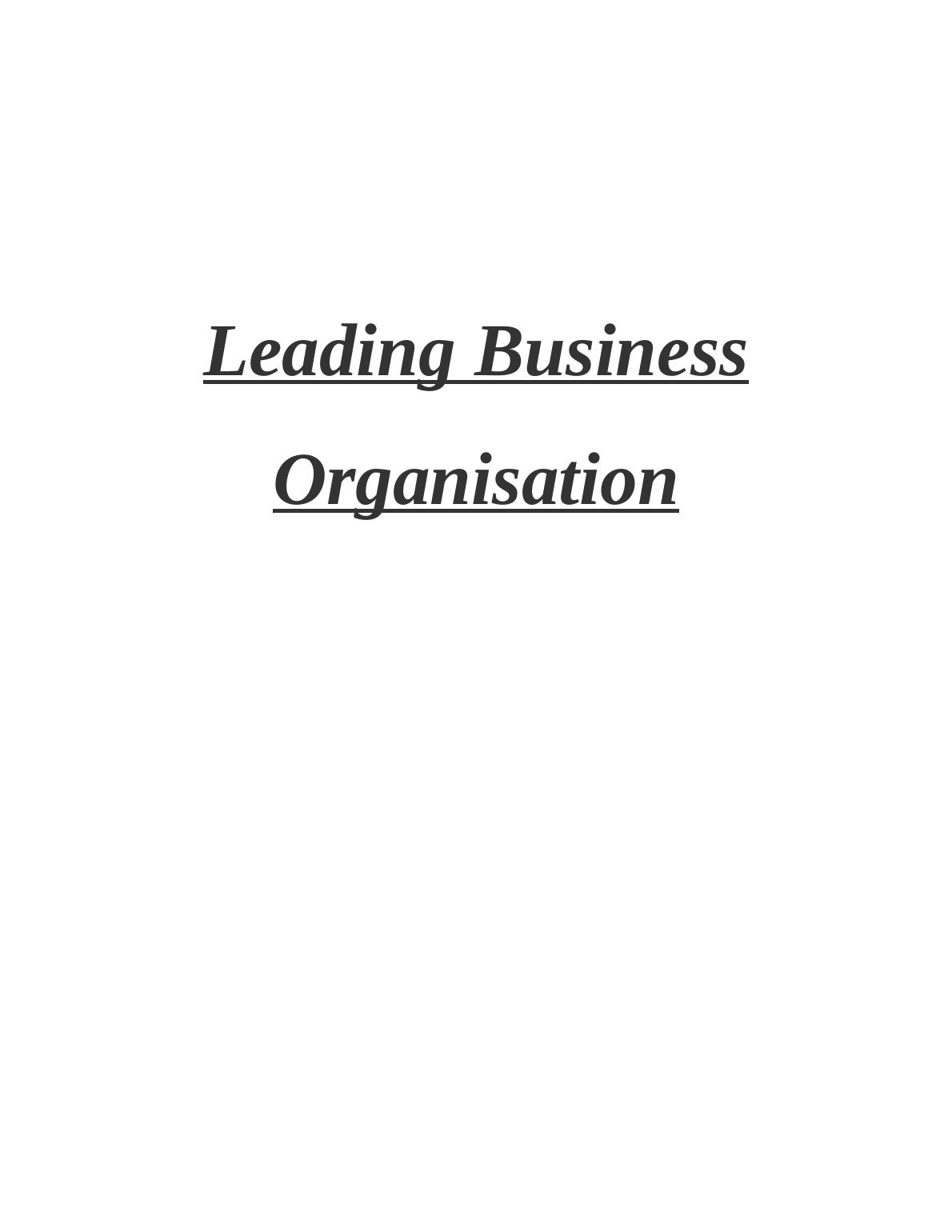
Contents
INTRODUCTION...........................................................................................................................3
REFLECTION ................................................................................................................................3
1. Systematic understanding of leadership theories...................................................................3
2 Capacity to assess the Contribution in Executing Mission and Vision of Organization
Leaders........................................................................................................................................5
3. Capacity to apply leadership strategies to maximize organizational potential.....................6
4. Capacity to assess motivational theories within organizational environment for leaders...7
5. Potential leadership style.......................................................................................................9
2. MANAGEMENT REPORT......................................................................................................10
a. Introduction of the report......................................................................................................10
B. Overview of servant leadership style and related challenges to practice.............................10
C. Critical evaluation of Kevin Johnson’s leadership style.....................................................13
d. About Johnson’s strong personal brand as ab effective global leader..................................15
e. Recommendations.................................................................................................................16
CONCLUSION..............................................................................................................................16
REFERENCES..............................................................................................................................18
INTRODUCTION...........................................................................................................................3
REFLECTION ................................................................................................................................3
1. Systematic understanding of leadership theories...................................................................3
2 Capacity to assess the Contribution in Executing Mission and Vision of Organization
Leaders........................................................................................................................................5
3. Capacity to apply leadership strategies to maximize organizational potential.....................6
4. Capacity to assess motivational theories within organizational environment for leaders...7
5. Potential leadership style.......................................................................................................9
2. MANAGEMENT REPORT......................................................................................................10
a. Introduction of the report......................................................................................................10
B. Overview of servant leadership style and related challenges to practice.............................10
C. Critical evaluation of Kevin Johnson’s leadership style.....................................................13
d. About Johnson’s strong personal brand as ab effective global leader..................................15
e. Recommendations.................................................................................................................16
CONCLUSION..............................................................................................................................16
REFERENCES..............................................................................................................................18
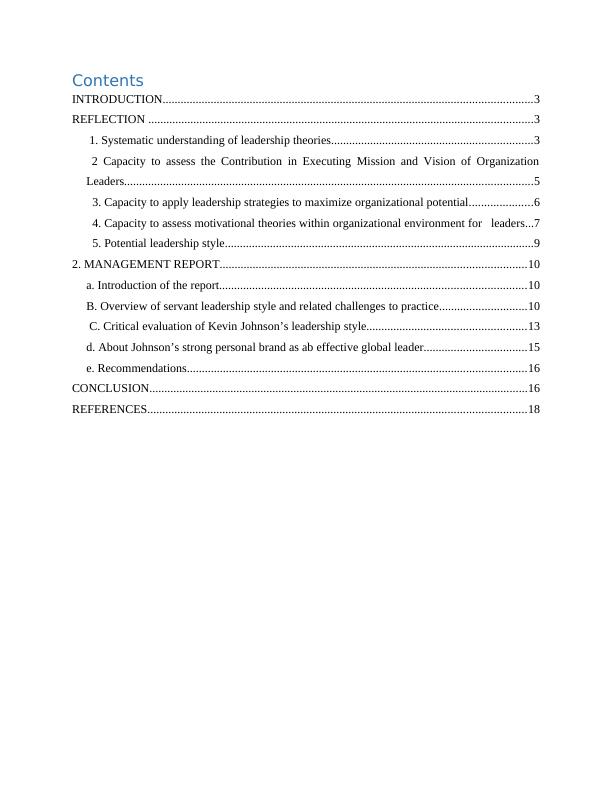
INTRODUCTION
Leadership is the process through which an individual guide, motivate and control people
and group of individuals. It is the way of a person working in the organization to control and
influence the behaviour of employees and achieve organizational goal. In every business
organization leadership play an main role, Higher authorities and directors evolve ideas and
strategies to maintain and leaders provide guidance to workforce how to reaches to goals in
effective manner. It is a style of leaders which influence the behaviour of employees at work
towards the achievement of organizational goal (Henderson, Castner and Schneider, 2018). The
task will ensure various aspect which facilitate knowledge of leadership and leadership styles
which help in expansion & evolvement of a person.
This report is conducted on management of Starbucks, report consist leadership style of
servant besides with provocation, short survey of case study, censorious assessment of leadership
style of Kevin Johnson, discussion on Kevin Johnson style of leadership and advice as well as
accomplishment of task. The business organization which is selected for this present report is
Starbucks. The company was established in 1971 and it headquarter is in Seattle, Washington. It
is a worldwide series of coffee and provide various kinds of coffee on its outlet. With this,
company also provide food products to consumers.
REFLECTION
1. Systematic understanding of leadership theories
A. What are the two fundamental questions that leaders ask to themselves?
There are various questions that a leader needed to ask themselves which will assist in
improving performance and profitability of staff members. The question are as follows:
What are the information needed for developing effective policies and strategies
for organisation?
What are the skills and competencies required to motivate and encourage staff
members of the organisation?
The earliest need to be analyse aspects which is mention in an information and this is too
connected with expansion in the information group as long as of customization and services. The
Leadership is the process through which an individual guide, motivate and control people
and group of individuals. It is the way of a person working in the organization to control and
influence the behaviour of employees and achieve organizational goal. In every business
organization leadership play an main role, Higher authorities and directors evolve ideas and
strategies to maintain and leaders provide guidance to workforce how to reaches to goals in
effective manner. It is a style of leaders which influence the behaviour of employees at work
towards the achievement of organizational goal (Henderson, Castner and Schneider, 2018). The
task will ensure various aspect which facilitate knowledge of leadership and leadership styles
which help in expansion & evolvement of a person.
This report is conducted on management of Starbucks, report consist leadership style of
servant besides with provocation, short survey of case study, censorious assessment of leadership
style of Kevin Johnson, discussion on Kevin Johnson style of leadership and advice as well as
accomplishment of task. The business organization which is selected for this present report is
Starbucks. The company was established in 1971 and it headquarter is in Seattle, Washington. It
is a worldwide series of coffee and provide various kinds of coffee on its outlet. With this,
company also provide food products to consumers.
REFLECTION
1. Systematic understanding of leadership theories
A. What are the two fundamental questions that leaders ask to themselves?
There are various questions that a leader needed to ask themselves which will assist in
improving performance and profitability of staff members. The question are as follows:
What are the information needed for developing effective policies and strategies
for organisation?
What are the skills and competencies required to motivate and encourage staff
members of the organisation?
The earliest need to be analyse aspects which is mention in an information and this is too
connected with expansion in the information group as long as of customization and services. The
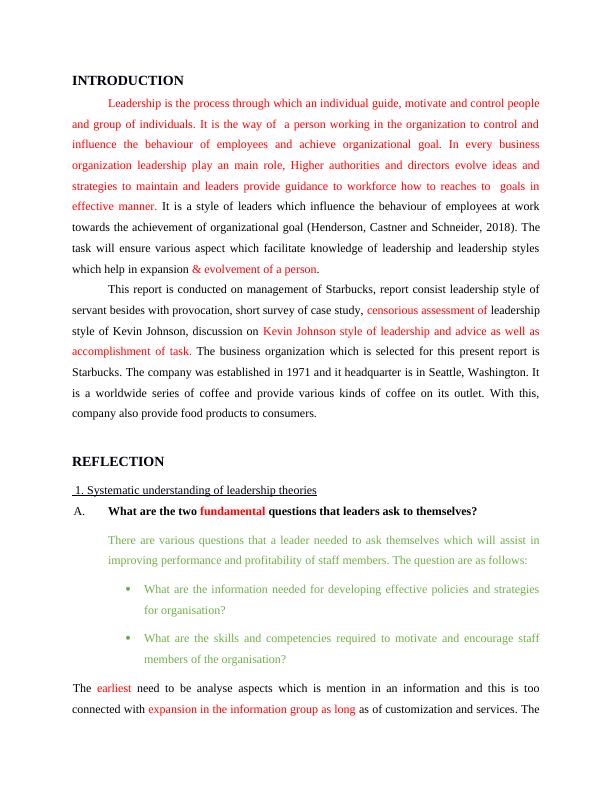
second is related to proper allocation of resources as well as analyzing internal and external
factors of company in order to make better strategy in organization.
B. What are the two aspect of leadership?
There are various key aspects of leadership that is given below:
It is important for a leader to maintain an effective relationship with employees so
that they can retain with organisation for longer time period.
There are various situations arise at workplace at the time of leading teams. So it
is essential for a leader to be effective and creative in order to resolve issues
within time period.
C. What is leadership theory?
There are various ways by which a leader can lead teams and groups of an organisation.
Leadership style mainly emphasis on behaviour and traits of a leader which will assist them to
achieve higher growth & success in an effective manner. It is analysed that there is no particular
leadership style is appropriate for a business entity. Therefore, it is significant for leaders to
make use of a suitable leadership styles as per the business situation and market as well.
D. Name two non-identical kind of leadership styles that are suitable for organizational
culture?
Pacesetting: In this type of leadership style, a leader guides from the front and set high
standards for their groups. In addition to this, leaders expects from employees to exceed with
minimal management. It is determined that such leadership style is effective to attain sort term
results and also detrimental for motivation in long-run.
Coaching: It is relatively new as well as guiding leadership style. Herein, the leaders
takes the lead to get the best from his staff members or the team. It is analysed that the basis of
coaching leadership style is dynamic interaction among the employee and the leader.
factors of company in order to make better strategy in organization.
B. What are the two aspect of leadership?
There are various key aspects of leadership that is given below:
It is important for a leader to maintain an effective relationship with employees so
that they can retain with organisation for longer time period.
There are various situations arise at workplace at the time of leading teams. So it
is essential for a leader to be effective and creative in order to resolve issues
within time period.
C. What is leadership theory?
There are various ways by which a leader can lead teams and groups of an organisation.
Leadership style mainly emphasis on behaviour and traits of a leader which will assist them to
achieve higher growth & success in an effective manner. It is analysed that there is no particular
leadership style is appropriate for a business entity. Therefore, it is significant for leaders to
make use of a suitable leadership styles as per the business situation and market as well.
D. Name two non-identical kind of leadership styles that are suitable for organizational
culture?
Pacesetting: In this type of leadership style, a leader guides from the front and set high
standards for their groups. In addition to this, leaders expects from employees to exceed with
minimal management. It is determined that such leadership style is effective to attain sort term
results and also detrimental for motivation in long-run.
Coaching: It is relatively new as well as guiding leadership style. Herein, the leaders
takes the lead to get the best from his staff members or the team. It is analysed that the basis of
coaching leadership style is dynamic interaction among the employee and the leader.

In the present VUCA world it can be said that environment is highly descriptive. There is
need of leadership for creation of a vision. VUCA stands for volatile, uncertain, complex &
Ambiguous. There are certain aspects that have to be taken into consideration by leaders in
organisation like Starbucks. These are part of changing nature and have to be dealt to enhance
individual performance.
Volatile is a aspect that is related with unpredictably of change that can take place suddenly or
extremely.
Uncertain is not known that not definite and unclear about the present situation that cannot be
relied on.
Complex is different connected parts, there are key decision factors that consist of interaction
between emergence, diverse agents, adaption.
Ambiguous that is understand meaning of recent in different ways.
E. Why do aspiring leaders need complete understanding about leadership style?
In order to become an effective leader, it is necessary to adopt appropriate leadership
style and knowledge of each and every type of leadership style is also important. Information
about each and every leadership style helps leader in selecting appropriate style.
Leaders have to use leadership style such as there is use of autocratic or democratic
leadership style that can help in the process of decision making. In case of autocratic leadership
style it help in making decision without giving any consideration to view point of other
employees. Sometimes there is need to consider the views of other employees that can help in
smooth decisions that can be taken by leaders. So in situations they can change their decision if
they are willing to do so.
It is significant for the leaders to have a proper and effective knowledge about leadership
styles so that they can use it as per the situations occurred. In addition to this, it is analysed that
using of appropriate leadership styles help an entity to implement task in an effective and
appropriate manner that has direct influence on the overall growth and performance of an
organisation in a positive manner.
2 Capacity to assess the Contribution in Executing Mission and Vision of Organization Leaders
A. What is organization’s Mission and Vision?
need of leadership for creation of a vision. VUCA stands for volatile, uncertain, complex &
Ambiguous. There are certain aspects that have to be taken into consideration by leaders in
organisation like Starbucks. These are part of changing nature and have to be dealt to enhance
individual performance.
Volatile is a aspect that is related with unpredictably of change that can take place suddenly or
extremely.
Uncertain is not known that not definite and unclear about the present situation that cannot be
relied on.
Complex is different connected parts, there are key decision factors that consist of interaction
between emergence, diverse agents, adaption.
Ambiguous that is understand meaning of recent in different ways.
E. Why do aspiring leaders need complete understanding about leadership style?
In order to become an effective leader, it is necessary to adopt appropriate leadership
style and knowledge of each and every type of leadership style is also important. Information
about each and every leadership style helps leader in selecting appropriate style.
Leaders have to use leadership style such as there is use of autocratic or democratic
leadership style that can help in the process of decision making. In case of autocratic leadership
style it help in making decision without giving any consideration to view point of other
employees. Sometimes there is need to consider the views of other employees that can help in
smooth decisions that can be taken by leaders. So in situations they can change their decision if
they are willing to do so.
It is significant for the leaders to have a proper and effective knowledge about leadership
styles so that they can use it as per the situations occurred. In addition to this, it is analysed that
using of appropriate leadership styles help an entity to implement task in an effective and
appropriate manner that has direct influence on the overall growth and performance of an
organisation in a positive manner.
2 Capacity to assess the Contribution in Executing Mission and Vision of Organization Leaders
A. What is organization’s Mission and Vision?
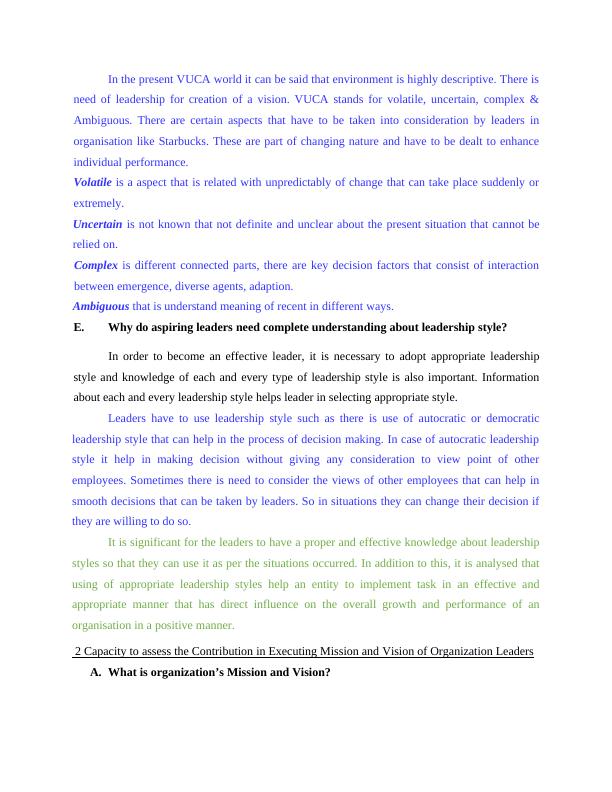
Vision is something seen it can be an objective of an organization which they can perceived
visually (Gotsis and Grimani, 2016). Vision simply is an ideal or a goal towards which
organization aspires. Mission is purpose or reason of an organization, what it stands for and why
it exists.
B. What role does personnel make in executing Mission and Vision?
Organization is able to achieve their goals & objectives only because of employees so,
workforce play an essential role while implementing vision and mission of a
company.Individuals play a very crucial role in achievement of organisation's objectives that
have to be in synchronisation with the objectives of organisation. Individuals help in supporting
the functions to be performed in more creative manner. In addition to this, it is analysed that
staff members implement out all the activities as per the instruction which help an entity to attain
organisational objectives within given time period.
C. What contribution does leader make in executing mission and vision?
Leaders are the real motivator; they develop strategies in sequence to reaches goals &
also guide or direct employees toward vision and mission of an organization. In addition to this,
it is analysed that leaders aligned all the activities with the set vision and mission of company
and the direct employees to achieve it in a timely and effective manner.
C. What contribution does stakeholders make in executing the mission and vision?
Stakeholders play an important role in every business organization, group of stakeholders
include employees, customers, suppliers, government, stockholders’ company is able to achieve
their vision and mission only under the assistance of stakeholders group. Stakeholders are key
aspects in every organisation that possess influence in functioning of whole organisation in
present and future context. It helps in understand of employees through their vision and mission
so that they can understand their strategy and its future implementation. Moreover, stakeholders
such as employees give their full potential in order to achieve organisational objectives that leads
to increase in performance and profitability of a company.
E. What does leaders require to construct for assessment of contributions?
Leaders need to evaluate contribution of each and every employee in sequence to reduce
conflicts and to make better the performance of workforce or other respective area.
visually (Gotsis and Grimani, 2016). Vision simply is an ideal or a goal towards which
organization aspires. Mission is purpose or reason of an organization, what it stands for and why
it exists.
B. What role does personnel make in executing Mission and Vision?
Organization is able to achieve their goals & objectives only because of employees so,
workforce play an essential role while implementing vision and mission of a
company.Individuals play a very crucial role in achievement of organisation's objectives that
have to be in synchronisation with the objectives of organisation. Individuals help in supporting
the functions to be performed in more creative manner. In addition to this, it is analysed that
staff members implement out all the activities as per the instruction which help an entity to attain
organisational objectives within given time period.
C. What contribution does leader make in executing mission and vision?
Leaders are the real motivator; they develop strategies in sequence to reaches goals &
also guide or direct employees toward vision and mission of an organization. In addition to this,
it is analysed that leaders aligned all the activities with the set vision and mission of company
and the direct employees to achieve it in a timely and effective manner.
C. What contribution does stakeholders make in executing the mission and vision?
Stakeholders play an important role in every business organization, group of stakeholders
include employees, customers, suppliers, government, stockholders’ company is able to achieve
their vision and mission only under the assistance of stakeholders group. Stakeholders are key
aspects in every organisation that possess influence in functioning of whole organisation in
present and future context. It helps in understand of employees through their vision and mission
so that they can understand their strategy and its future implementation. Moreover, stakeholders
such as employees give their full potential in order to achieve organisational objectives that leads
to increase in performance and profitability of a company.
E. What does leaders require to construct for assessment of contributions?
Leaders need to evaluate contribution of each and every employee in sequence to reduce
conflicts and to make better the performance of workforce or other respective area.
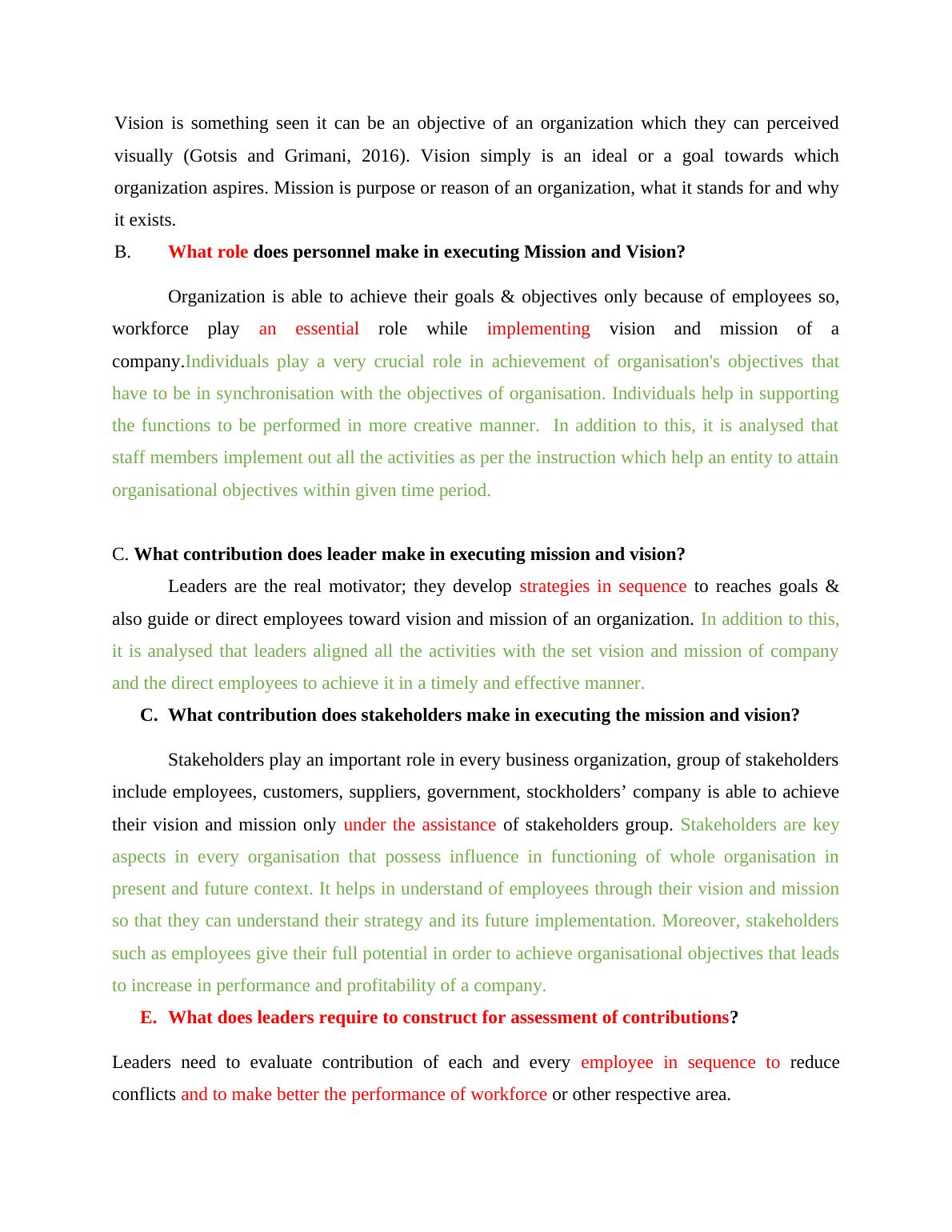
End of preview
Want to access all the pages? Upload your documents or become a member.
Related Documents
Leadership Theories and Organizations: Benefits for Aspiring Leaderslg...
|14
|4363
|36
Leadership Theories and Organizational Behavior in Leading Business Organizationslg...
|14
|4794
|76
Leadership Styles and Challenges in VUCA Environmentlg...
|16
|4184
|57
Leadership Theories and Organizational Benefits for Aspiring Leaders at Starbuckslg...
|18
|4214
|69
Leadership in Business Organisationslg...
|16
|4762
|66
Evaluation of the President of Starbucks Leadership Stylelg...
|13
|4451
|92
